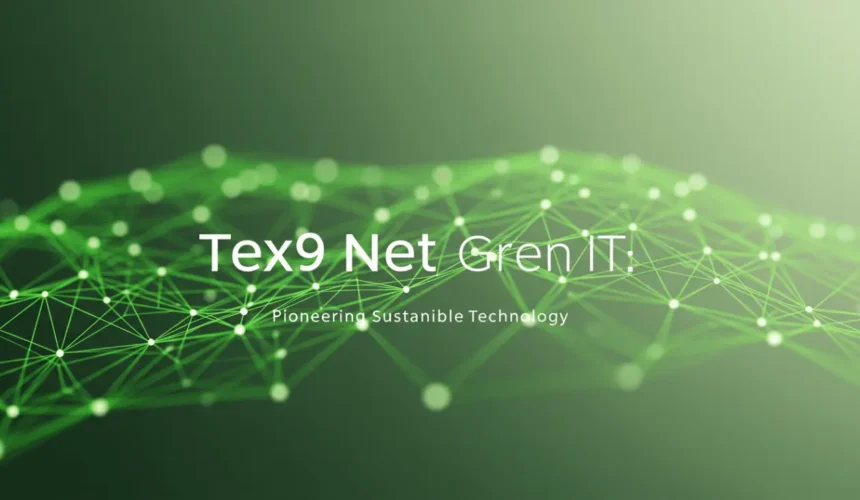In 2025, every swipe, stream, and sensor ping leaves an electrical footprint, yet consumers rarely see the kilowatts or carbon particles dancing behind their screens. Tex9 Net Green IT brings that invisible cost into sharp focus and then shows how to shrink it. By weaving sustainability targets into architecture diagrams, sprint planning, and release gates, the framework embeds efficiency from day one. It champions renewable‑powered data centers, lightweight code, and circular hardware management, proving that climate action and performance can reinforce—rather than contradict—each other. That convergence between digital ambition and environmental stewardship defines the next era of competitive advantage.
Green IT in a Nutshell
Industry scholars distinguish between Green by IT—technologies that enable environmental progress, such as energy‑tracking dashboards, smart grids, and intelligent logistics—and Green in IT, which seeks to slim down the footprint of the infrastructure itself through low‑power processors, advanced cooling, and clean‑energy procurement. By merging both lenses, developers ensure that a solution’s very fabric is sustainable rather than merely its end goal. Research on Tex9.net stresses that the synergy between these strands delivers multiplicative, not additive, benefits: efficient code running on efficient silicon magnifies carbon savings.
How the Tex9 Net Green IT Initiative Delivers Impact
How does the Tex9 Net Green IT initiative translate theory into practice? First, Tex9.net curates data‑center partners with sub‑1.2 PUE scores, each powered by wind, solar, or small‑scale hydro generation. Second, the platform promotes stateless microservices, serverless functions, and edge caching—an architecture trio that slashes idle compute hours and long‑haul data transfers. Third, it enforces rigorous e‑waste governance: asset tags link every device to a refurbishment, resale, or certified recycling pathway, dramatically cutting landfill leakage.
Real‑time dashboards display power draw, water‑usage effectiveness, and carbon‑per‑transaction metrics so engineers can watch the environmental dial move with every CI/CD push. Analysts describe the approach as connecting rapid technological progress with tangible carbon savings—smarter energy use, optimized infrastructure, and minimal e‑waste bundled into a single, developer‑friendly workflow.
Business Upsides That Go Beyond Compliance
Naturally, looming carbon taxes and shareholder ESG demands strengthen the case for greener tech; however, the Tex9 Net Green IT business upside runs far deeper. Lower‑power workloads slash utility bills, a critical factor in regions where electricity‑price volatility can wreak havoc on OpEx forecasts. Modular devices extend refresh cycles, freeing capital for research or acquisitions instead of repetitive hardware swaps.
Moreover, sustainability credentials increasingly influence procurement scorecards—particularly within EU and UK public tenders—so early adopters gain access to revenue streams competitors cannot touch. A credible climate narrative also sweetens employer brands, lowering churn in high‑demand talent pools and boosting engagement. In short, green operations evolve from risk mitigation into a profit‑and‑people strategy.
Practical Best Practices
Translating intention into daily action begins with a few high‑impact moves. Within the Tex9 Net Green IT framework:
- Move workloads to green regions. Hyperscalers now publish real‑time carbon‑intensity dashboards that guide scheduling.
- Enable autoscaling and right‑sizing. Virtual machines should spin only when business value justifies their joules.
- Embrace circular procurement. Specify repairable, modular devices with take‑back guarantees in supplier contracts.
- Bake carbon budgets into code reviews. Architecture decision records and pull‑request templates should track kilowatt‑hours alongside milliseconds.
- Time batch jobs to renewable peaks. Orchestration platforms can use grid‑carbon signals to choose the cleanest execution windows.
Collectively, these steps can cut a digital footprint by double‑digit percentages within a single budget cycle, mirroring the broader shift toward zero‑emission cloud services.
Culture: The Hidden Multiplier
Equally important is culture. When green thinking becomes a first‑class engineering value—like security or resiliency—it scales far beyond top‑down mandates. Tex9.net encourages “carbon champions” in every scrum team to audit pipelines and share tips during retros. Gamified dashboards light up green when targets are met, turning sustainability into a friendly contest rather than a compliance chore. Hack‑days devoted to carbon‑aware coding often surface optimizations that formal audits miss, proving that creativity flourishes when developers personally own the challenge.
A Phased Roadmap
- Set a baseline. Use agentless discovery tools to log energy, cooling loads, and firmware age across all sites.
- Harvest quick wins. Switch idle‑heavy applications to serverless and replace legacy UPS units with higher‑efficiency models.
- Codify policies. Integrate Tex9 Net Green IT thresholds—such as sub‑50 gCO₂e per API call—into procurement and design standards.
- Reward progress. Tie 10 % of performance bonuses to measurable efficiency gains, publishing cross‑team league tables for transparency.
- Report, learn, repeat. Release quarterly ESG bulletins, celebrate milestones publicly, and feed lessons back into product roadmaps.
Looking Ahead
Ultimately, embracing Tex9 Net Green IT is less about ticking compliance boxes and more about redefining digital excellence. As net‑zero deadlines edge closer, technology teams will be judged on carbon intensity per compute cycle alongside uptime and innovation. Firms that master the framework early will differentiate not only through cleaner operations but also through the innovation flywheel that green constraints inspire—lighter code, smarter algorithms, and architectures built for graceful scaling. By acting today, organizations can future‑proof their balance sheets, fortify their reputations, and, above all, safeguard the finite ecosystem that underpins every digital dream.







